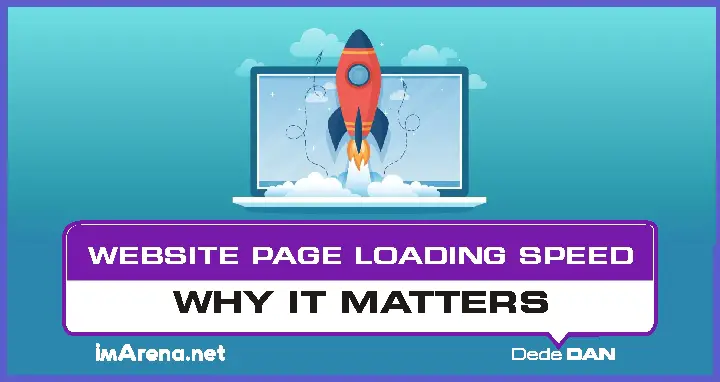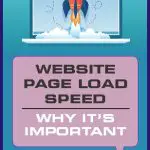

I hope you enjoy reading this blog post.
If you want my team to just do your marketing for you, click here.
With online businesses vying for attention and consumer loyalty, website speed is often an overlooked factor that can make or break success. While paid marketing, content strategies, social media presence, and appealing design may dominate the conversation, the performance of a website in terms of loading speed is equally vital.
This comprehensive guide explores why website speed matters, its impact on search engine rankings, and effective strategies for improving it.
Why Website Speed Matters
First, let’s look at some reasons why website speed matters for online properties:
– First Impressions and User Experience
As the saying goes, “The first impression is the last impression.” This adage holds true for websites as well. Visitors quickly form judgments about a website’s quality and the associated business based on its loading speed. If a website is slow or difficult to navigate, users are unlikely to return, resulting in lost opportunities for engagement and conversions. A fast-loading website, on the other hand, creates a positive user experience and fosters trust.
– User Impatience and Expectations
Today’s online consumers are constantly on the move and have high expectations for speed and efficiency. They demand instant access to information and seamless browsing experiences. If a website fails to meet these expectations, users are quick to abandon it in favor of faster alternatives. Even established brands cannot afford to ignore website speed, as only high-authority sites enjoy the luxury of user forgiveness for occasional technical issues.
– User Experience and Business Goals
The goal of digital marketing is to attract users and encourage them to engage with the products or services offered. However, this objective can only be achieved by delivering an exceptional user experience. Regardless of the type of website, whether it’s a blog, an online store, or a service platform, a good loading speed is essential for providing a smooth user experience. Without fast loading times, even the best content or products may go unnoticed, hindering conversions and business growth.

My Agency can Help You Make Money Online
Cashcow Videos - we create engaging faceless cashcow and business explainer videos that earn passive income.
Monetized Blogs - select from our list of ready-made niche blogs that are already approved for monetization.
Business or Website Traffic - using various digital marketing strategies, we drive massive amounts of targeted traffic to your website.
– Conversion Rates and Revenue Potential
The impact of website speed on conversion rates cannot be overstated. Research suggests that if a website takes longer than three seconds to load, approximately 40% of visitors are likely to abandon it.
Several companies have discovered that even a slight reduction in page load time can lead to higher conversion rates:
- Mobify observed that decreasing the load time of their homepage by 100 milliseconds resulted in a 1.11% increase in session-based conversions.
- Retailer AutoAnything witnessed a 12-13% surge in sales after cutting the page load time in half.
- Walmart found that enhancing the page load time by one second led to a 2% boost in conversions.
This high bounce rate translates into missed opportunities for customer acquisition and revenue generation. By prioritizing website speed and optimizing loading times, businesses can significantly increase their chances of converting visitors into paying customers, leading to improved revenue potential.
Factors Affecting Site Speed
Page weight: The resources required to load a website, like JavaScript, video, CSS, and high-resolution images, significantly impact the load time. Increased resource “weight” slows down the webpage, analogous to a waiter struggling to serve a table with numerous dishes.
Web complexity: With advancing web technologies, websites have become more complex. Developers can incorporate multiple JavaScript functions, third-party ads, and dynamic backgrounds, making it challenging to keep websites light and fast-loading.
Network conditions: Even lightweight websites may load slowly due to slow network connectivity. Factors such as local networking equipment, ISP service quality, and mobile devices using 3G/4G instead of WiFi affect loading speeds. Developers can implement techniques like minification, compression, and content delivery networks (CDNs) to expedite resource delivery over slower connections.
Hosting location: When website content needs to travel long distances to reach users, network latency increases. For example, if a website’s files are hosted in different data centers across states, users on the west coast may experience delays as the files traverse thousands of miles to their devices.
Significance of Website Speed in SEO
Search engine optimization is crucial for businesses to improve their online visibility and attract organic traffic. Search engines, especially Google, use various ranking factors to determine the relevance and quality of websites.
In May 2021, Google introduced Core Web Vitals, a set of user-centric metrics that measure loading, interactivity, and visual stability. These metrics, combined with existing search signals, help Google assess how users perceive a webpage’s speed and overall experience.
Core Web Vitals and Improved Rankings
With the introduction of Core Web Vitals, website speed has become an even more critical factor in Google’s search ranking algorithm. Faster websites now have a higher chance of ranking higher in search results, making them more discoverable to potential customers. By aligning with Google’s emphasis on user experience and optimizing website speed, businesses can gain a competitive edge and increase their chances of reaching their target audience.
Site Speed Updates to Google Search Ranking
Google’s mission is to connect users with relevant and high-quality sites. The incorporation of Core Web Vitals into the search ranking algorithm further refines this process. Let’s briefly explore these user-centric metrics:
Largest Contentful Paint (LCP)
LCP measures how long it takes for a page’s main content to load. A faster LCP ensures that users quickly find the information they seek, enhancing the perceived speed of the website.
First Input Delay (FID)
FID gauges the time between a user’s interaction with a page (e.g., clicking a link or button) and the browser’s response. A lower FID indicates better interactivity and usability.
Cumulative Layout Shift (CLS)
CLS measures the frequency of unexpected layout shifts during page loading. Minimizing CLS enhances visual stability and ensures a seamless user experience.
These Core Web Vitals, coupled with existing search signals, gauge users’ perception of webpage speed and inform Google’s search rankings. By focusing on improving site speed, businesses can enhance their online visibility and attract more potential customers.
Strategies for Improving Website Speed
In order to enhance your website’s performance and provide a seamless user experience, it is crucial to implement effective strategies for improving website speed. You can increase conversions and retention rates, while also improving your search engine rankings. Here are some techniques to boost your website’s speed and stay ahead of the competition.
Conducting a Site Speed Audit
Before diving into improvements, it is essential to understand the current performance of your website. Utilize site speed test tools and reports available, such as Shopify’s online store speed report, to assess your site’s speed and compare it with similar businesses. This audit will provide valuable insights into areas that require optimization and help prioritize efforts.
How to Improve Website Speed
To remain competitive in the online business space, businesses must proactively optimize their website speed. Here’s a step-by-step guide to achieving faster load times:
1. Understand Your Current Site Speed
Before making improvements, assess your website’s performance using online speed testing tools. Compare your site speed to similar businesses to identify areas for enhancement.
2. Make Site Speed Improvements
Examine your website thoroughly and implement changes that boost loading times. Minimize HTTP requests, leverage browser caching, and optimize code to reduce server response times.
3. Optimize Images
Images play a significant role in website speed. Compress images to reduce file sizes without compromising visual quality. Consider lazy loading techniques to prioritize the loading of visible content first.
4. Content Delivery Network (CDN) Integration
Implement a CDN to distribute your website’s static content across multiple servers globally. By reducing the physical distance between users and servers, a CDN improves loading times for visitors across various geographical locations.
5. Prioritize Mobile Optimization
As mobile usage continues to rise, prioritize mobile optimization to cater to on-the-go users. Implement responsive design, compress assets, and streamline the mobile experience to ensure fast-loading pages on smartphones and tablets.
6. Regularly Monitor and Test
Website speed optimization is an ongoing process. Continuously monitor your site’s performance, conduct regular speed tests, and identify areas for improvement. Stay up to date with technological advancements and industry best practices to maintain a competitive edge.
7. Implementing AMP (Accelerated Mobile Pages)
AMP is a web framework that prioritizes speed and mobile optimization. Implementing AMP can enhance website speed and improve mobile user experiences.
8. Prioritize Critical Resources
Employ techniques like lazy loading, asynchronous loading, and resource preloading to ensure essential elements load first and improve perceived speed.
9. Minimizing JavaScript and CSS
Reduce unnecessary code, combine and minify files, and employ asynchronous loading to streamline website rendering and improve performance.
Conclusion
In the ever-evolving world of digital marketing, website speed has emerged as a critical factor in achieving online success. It influences first impressions, user experience, conversion rates, and search engine rankings. Embrace the power of website speed, implement the right strategies, and set your business on the path to success in the digital realm.





